When I was born, there was no country called Burkina Faso. The area in question was a part of what was internationally referred to as French West Africa, and specifically the area above the tri-part Volta River, the Black Volta, White Volta, and Red Volta. In short order, however, while I was still suckling at a warmed bottle, it became the independent Republic of Upper Volta, and, in a simplistic rendition of the river placement, adopted this flag:
I was big into stamp collecting as a youngster, and I think I had all these elephant stamps, as well as quite a few others, from the country, as well as some of the older FWA stamps.
Along about 1983, following a Marxist coup, the country became known as Burkina Faso, a hybrid name between two of the principal indigenous languages of the country, mossi and dioula, and meaning, roughly, “the land of incorruptible men”. And bringing in a suffix from a third language, fula, added onto the burkina, gave burkinabé, or “upright person”. A new flag was adopted the next year:
The red symbolized the revolution that had just taken place, the yellow star the guiding light of that revolution, and the green, the abundance of natural resources of the land. The choice of colors was more or less guided by the traditional colors of the various flags of former French West African republics.
Today, after multiple coups, insurrections, and terrorist attacks, Burkina Faso is a poverty stricken, food insecure country, described as landlocked, dependent on an inadequate and irregular rainfall, with little to no modern infrastructure. It’s primary activity, in which 80% of the population is engaged, is agriculture, followed by mining of various sorts for most of the rest of the population. Its primary exports are cotton and gold. Not surprisingly, the latter is almost all owned by a few wealthy individuals.
The food is heavy on plant products, particularly starchy, calorie dense ones. On to our little project….
The soup was a relatively easy decision – peanut soup is pretty much the soup of the entire region, that old FWA area – peanuts having been introduced to the are by the Portuguese, and being cheaper and easier to grow than the native groundnut, it quickly supplanted it in local recipes. There are a variety of names for this dish, and I couldn’t offhand find one in the predominant language, mossi, but in fula, which is almost a lingua franca linking the various countries, it is called Maafé.
Starting in the back – we have a couple of chopped tomatoes, a large onion, a yellow bell pepper, about 3 cups of vegetable stock; in the middle, is a teaspoon each of salt, pepper, and a tablespoon of brown sugar, half a cup of peanut butter; and then across the front, a medium sized sweet potato, a handful of greens (I had radish greens in the house, so used those, though more traditionally would be something like collard or turnip greens), a 1″ knob of ginger, 2 cloves garlic, a couple of hot chilies, and 2 carrots.
In a little oil, saute the carrots, onion, bell pepper, garlic, ginger, and chilies until soft – about five minutes.
Add the sweet potato, tomato, and the vegetable stock, bring to a boil and cook for ten minutes.
And, it will look like this.
Then, puree in a blender – given that that’s probably not the traditional way a pureed soup was made, what I did was just pulse it a few times, so it’s not completely smooth. Now, the recipes I was following and kind of combined into this version have that at this point, you whisk in the peanut butter, the sugar, salt, and pepper, and add the chopped greens, and cook for a few minutes longer. I’m going to advocate that you put the peanut butter and seasonings into the blender, because peanut butter just doesn’t whisk well, and we ended up with much of it distributed, but several lumps of peanut butter here and there that we encountered when eating. Serve topped with chopped green onions and peanuts.
Now, traditional accompaniments to this soup vary, depending on region, tribe, and, probably, availability. Rice, or other grains, are common – millet and sorghum in particular. Fufu is basically a thick, stodgy porridge made from yuca root (basically tapioca starch porridge), that’s allowed to thicken to the point where you can tear off pieces of it. It’s exceptionally bland and kind of spongy, and I just couldn’t bring myself to make it. And, besides, there were so many possibilities to choose from. There was Tô, which is a sort of cake made from millet, sorghum, or corn, though that’s traditionally served with its own sauce. In the end, I went with a fritter, stretching, once again, the definition of “bread”, to make Boussan Touba, black-eyed pea fritters….
Simple and easy. Pre-soak about a pound of black eyed peas overnight in water, then drain them. You need a small onion (I only had large ones, so this is half of a large one), a carrot, an egg, a teaspoon of salt and half a teaspoon of pepper.
Boil the beans and carrot together in water until soft.
Then mash… yeah, that’s gonna happen… pulse until coarsely pureed in a food processor with the onion, egg, and seasonings.
Form into patties, dredge in flour, and fry in peanut oil over medium heat, roughly five minutes on a side – don’t let them burn, but you want them well browned.
And, voilá!
The fritters were kind of bland, so it was a perfect opportunity to try out a bottle of a fiery hot sauce that a customer brought me from his hot sauce company, Culley’s, in New Zealand…. Let’s just say that the name is apt – searingly hot, but damn it was good.
And….
Dinner is served! Other than the egg in the fritter, this is a vegan meal. And the soup was the winning part of this combo. I can’t say I was fond of the fritters, even with the hot sauce. But I’d happily make this soup again – and perhaps in future west African ventures, we’ll explore one or more of the regional variations on the theme.
Next time… we’re staying here in Africa and heading to the east side and Burundi! Change of plans, as I went momentarily out of order and went to Canada next.
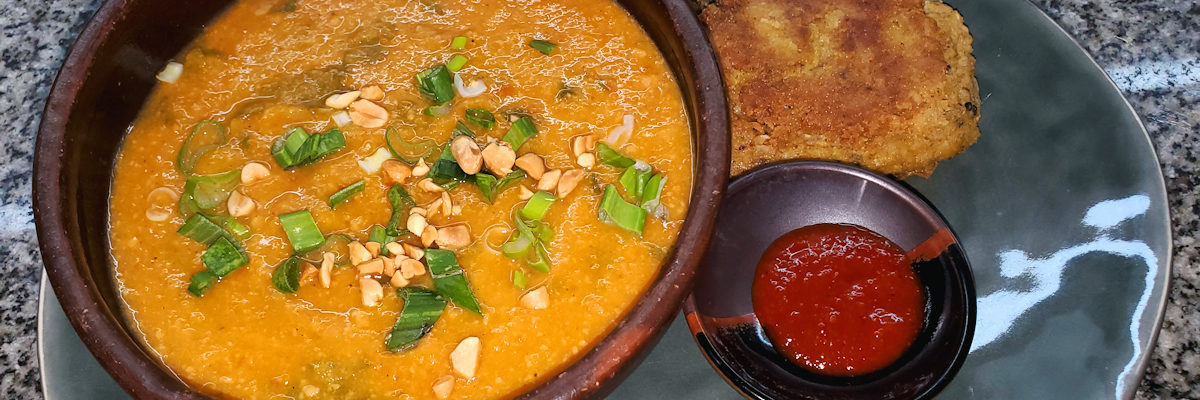
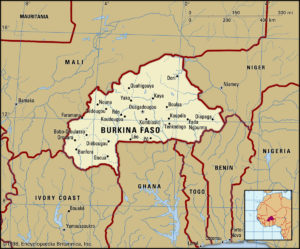
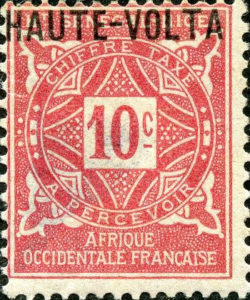
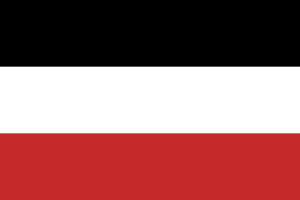
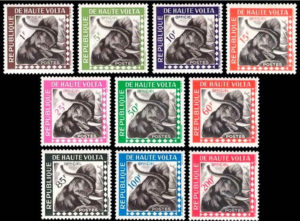
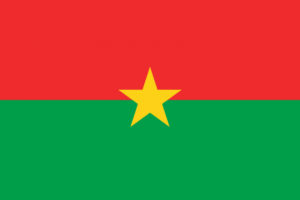
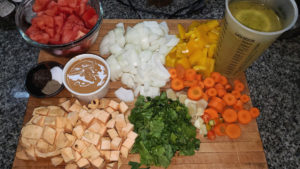
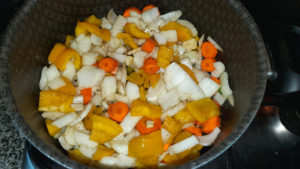

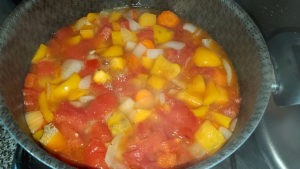
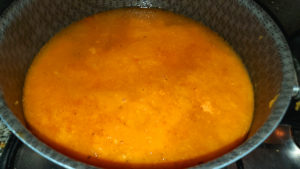

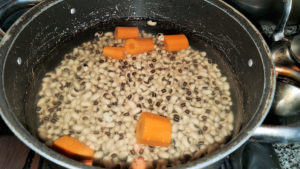
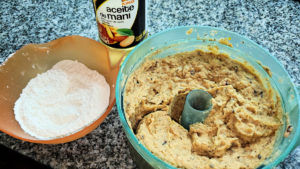
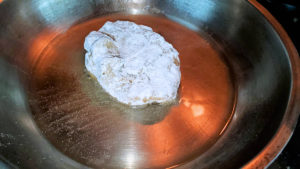
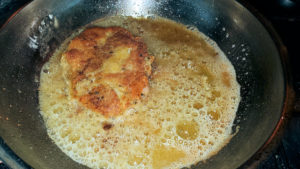
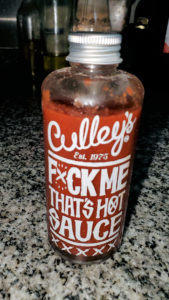
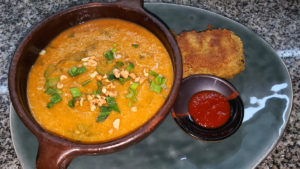
[…] there are still three more B’s to get through… next up, from landlocked Western Africa, Burkina Faso. What do I know about burkinabé […]